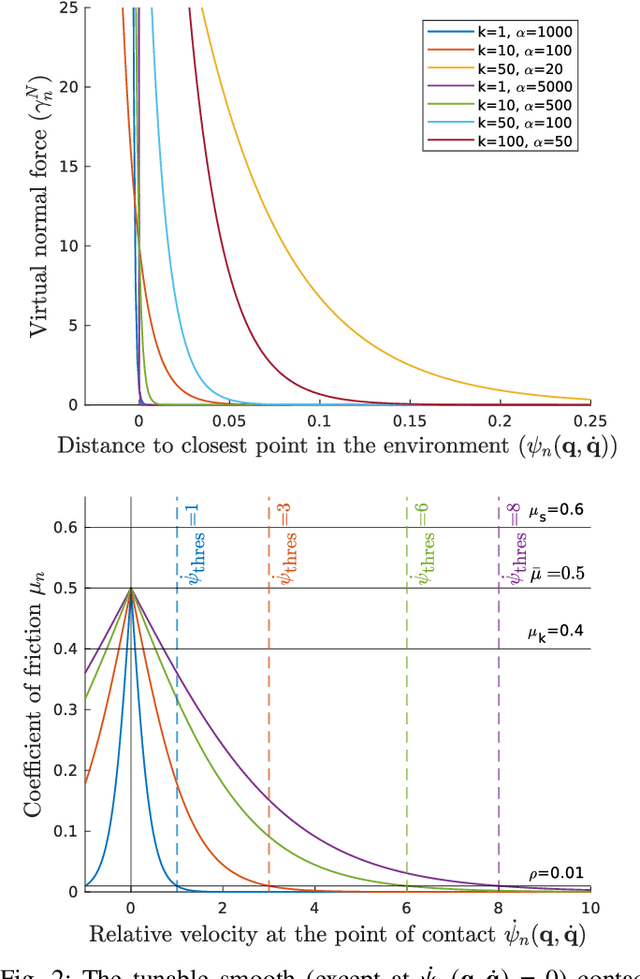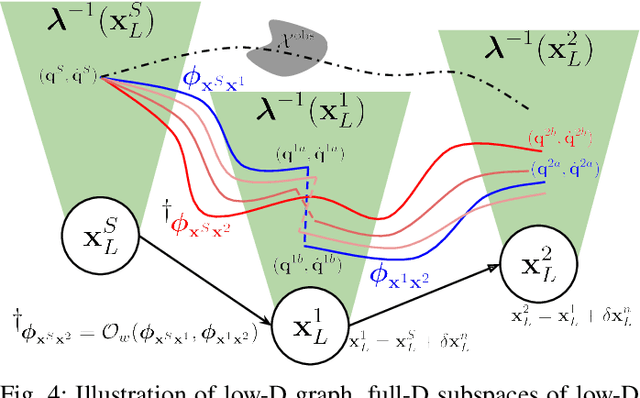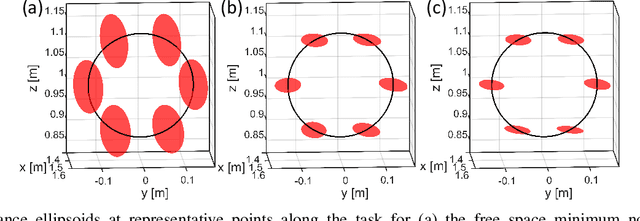Garrison L. H. Johnston
Multi-Modal Gesture Recognition from Video and Surgical Tool Pose Information via Motion Invariants
Mar 19, 2025Abstract:Recognizing surgical gestures in real-time is a stepping stone towards automated activity recognition, skill assessment, intra-operative assistance, and eventually surgical automation. The current robotic surgical systems provide us with rich multi-modal data such as video and kinematics. While some recent works in multi-modal neural networks learn the relationships between vision and kinematics data, current approaches treat kinematics information as independent signals, with no underlying relation between tool-tip poses. However, instrument poses are geometrically related, and the underlying geometry can aid neural networks in learning gesture representation. Therefore, we propose combining motion invariant measures (curvature and torsion) with vision and kinematics data using a relational graph network to capture the underlying relations between different data streams. We show that gesture recognition improves when combining invariant signals with tool position, achieving 90.3\% frame-wise accuracy on the JIGSAWS suturing dataset. Our results show that motion invariant signals coupled with position are better representations of gesture motion compared to traditional position and quaternion representations. Our results highlight the need for geometric-aware modeling of kinematics for gesture recognition.
A Feasibility Study of a Soft, Low-Cost, 6-Axis Load Cell for Haptics
Oct 04, 2024Abstract:Haptic devices have shown to be valuable in supplementing surgical training, especially when providing haptic feedback based on user performance metrics such as wrench applied by the user on the tool. However, current 6-axis force/torque sensors are prohibitively expensive. This paper presents the design and calibration of a low-cost, six-axis force/torque sensor specially designed for laparoscopic haptic training applications. The proposed design uses Hall-effect sensors to measure the change in the position of magnets embedded in a silicone layer that results from an applied wrench to the device. Preliminary experimental validation demonstrates that these sensors can achieve an accuracy of 0.45 N and 0.014 Nm, and a theoretical XY range of +/-50N, Z range of +/-20N, and torque range of +/-0.2Nm. This study indicates that the proposed low-cost 6-axis force/torque sensor can accurately measure user force and provide useful feedback during laparoscopic training on a haptic device.
Design Considerations for 3RRR Parallel Robots with Lightweight, Approximate Static-Balancing
Jun 22, 2023Abstract:Balancing parallel robots throughout their workspace while avoiding the use of balancing masses and respecting design practicality constraints is difficult. Medical robots demand such compact and lightweight designs. This paper considers the difficult task of achieving optimal approximate balancing of a parallel robot throughout a desired task-based dexterous workspace using balancing springs only. While it is possible to achieve perfect balancing in a path, only approximate balancing may be achieved without the addition of balancing masses. Design considerations for optimal robot base placement and the effects of placement of torsional balancing springs are presented. Using a modal representation for the balancing torque requirements, we use recent results on the design of wire-wrapped cam mechanisms to achieve balancing throughout a task-based workspace. A simulation study shows that robot base placement can have a detrimental effect on the attainability of a practical design solution for static balancing. We also show that optimal balancing using torsional springs is best achieved when all springs are at the actuated joints and that the wire-wrapped cam design can significantly improve the performance of static balancing. The methodology presented in this paper provides practical design solutions that yield simple, lightweight and compact designs suitable for medical applications where such traits are paramount.
Design Considerations and Robustness to Parameter Uncertainty in Wire-Wrapped Cam Mechanisms
Jun 22, 2023Abstract:Collaborative robots must simultaneously be safe enough to operate in close proximity to human operators and powerful enough to assist users in industrial tasks such as lifting heavy equipment. The requirement for safety necessitates that collaborative robots are designed with low-powered actuators. However, some industrial tasks may require the robot to have high payload capacity and/or long reach. For collaborative robot designs to be successful, they must find ways of addressing these conflicting design requirements. One promising strategy for navigating this tradeoff is through the use of static balancing mechanisms to offset the robot's self weight, thus enabling the selection of lower-powered actuators. In this paper, we introduce a novel, 2 degree of freedom static balancing mechanism based on spring-loaded, wire-wrapped cams. We also present an optimization-based cam design method that guarantees the cams stay convex, ensures the springs stay below their extensions limits, and minimizes sensitivity to unmodeled deviations from the nominal spring constant. Additionally, we present a model of the effect of friction between the wire and the cam. Lastly, we show experimentally that the torque generated by the cam mechanism matches the torque predicted in our modeling approach. Our results also suggest that the effects of wire-cam friction are significant for non-circular cams.
Task and Configuration Space Compliance of Continuum Robots via Lie Group and Modal Shape Formulations
Jun 22, 2023Abstract:Continuum robots suffer large deflections due to internal and external forces. Accurate modeling of their passive compliance is necessary for accurate environmental interaction, especially in scenarios where direct force sensing is not practical. This paper focuses on deriving analytic formulations for the compliance of continuum robots that can be modeled as Kirchhoff rods. Compared to prior works, the approach presented herein is not subject to the constant-curvature assumptions to derive the configuration space compliance, and we do not rely on computationally-expensive finite difference approximations to obtain the task space compliance. Using modal approximations over curvature space and Lie group integration, we obtain closed-form expressions for the task and configuration space compliance matrices of continuum robots, thereby bridging the gap between constant-curvature analytic formulations of configuration space compliance and variable curvature task space compliance. We first present an analytic expression for the compliance of a single Kirchhoff rod. We then extend this formulation for computing both the task space and configuration space compliance of a tendon-actuated continuum robot. We then use our formulation to study the tradeoffs between computation cost and modeling accuracy as well as the loss in accuracy from neglecting the Jacobian derivative term in the compliance model. Finally, we experimentally validate the model on a tendon-actuated continuum segment, demonstrating the model's ability to predict passive deflections with error below 11.5\% percent of total arc length.
Torque-Limited Manipulation Planning through Contact by Interleaving Graph Search and Trajectory Optimization
Oct 16, 2022



Abstract:Robots often have to perform manipulation tasks in close proximity to people. As such, it is desirable to use a robot arm that has limited joint torques so as to not injure the nearby person. Unfortunately, these limited torques then limit the payload capability of the arm. By using contact with the environment, robots can expand their reachable workspace that, otherwise, would be inaccessible due to exceeding actuator torque limits. We adapt our recently developed INSAT algorithm \cite{insat} to tackle the problem of torque-limited whole arm manipulation planning through contact. INSAT requires no prior over contact mode sequence and no initial template or seed for trajectory optimization. INSAT achieves this by interleaving graph search to explore the manipulator joint configuration space with incremental trajectory optimizations seeded by neighborhood solutions to find a dynamically feasible trajectory through contact. We demonstrate our results on a variety of manipulators and scenarios in simulation. We also experimentally show our planner exploiting robot-environment contact for the pick and place of a payload using a Kinova Gen3 robot. In comparison to the same trajectory running in free space, we experimentally show that the utilization of bracing contacts reduces the overall torque required to execute the trajectory.
Kinematic Modeling and Compliance Modulation of Redundant Manipulators Under Bracing Constraints
Aug 11, 2020



Abstract:Collaborative robots should ideally use low torque actuators for passive safety reasons. However, some applications require these collaborative robots to reach deep into confined spaces while assisting a human operator in physically demanding tasks. In this paper, we consider the use of in-situ collaborative robots (ISCRs) that balance the conflicting demands of passive safety dictating low torque actuation and the need to reach into deep confined spaces. We consider the judicious use of bracing as a possible solution to these conflicting demands and present a modeling framework that takes into account the constrained kinematics and the effect of bracing on the end-effector compliance. We then define a redundancy resolution framework that minimizes the directional compliance of the end-effector while maximizing end-effector dexterity. Kinematic simulation results show that the redundancy resolution strategy successfully decreases compliance and improves kinematic conditioning while satisfying the constraints imposed by the bracing task. Applications of this modeling framework can support future research on the choice of bracing locations and support the formation of an admittance control framework for collaborative control of ISCRs under bracing constraints. Such robots can benefit workers in the future by reducing the physiological burdens that contribute to musculoskeletal injury.
 Add to Chrome
Add to Chrome Add to Firefox
Add to Firefox Add to Edge
Add to Edge